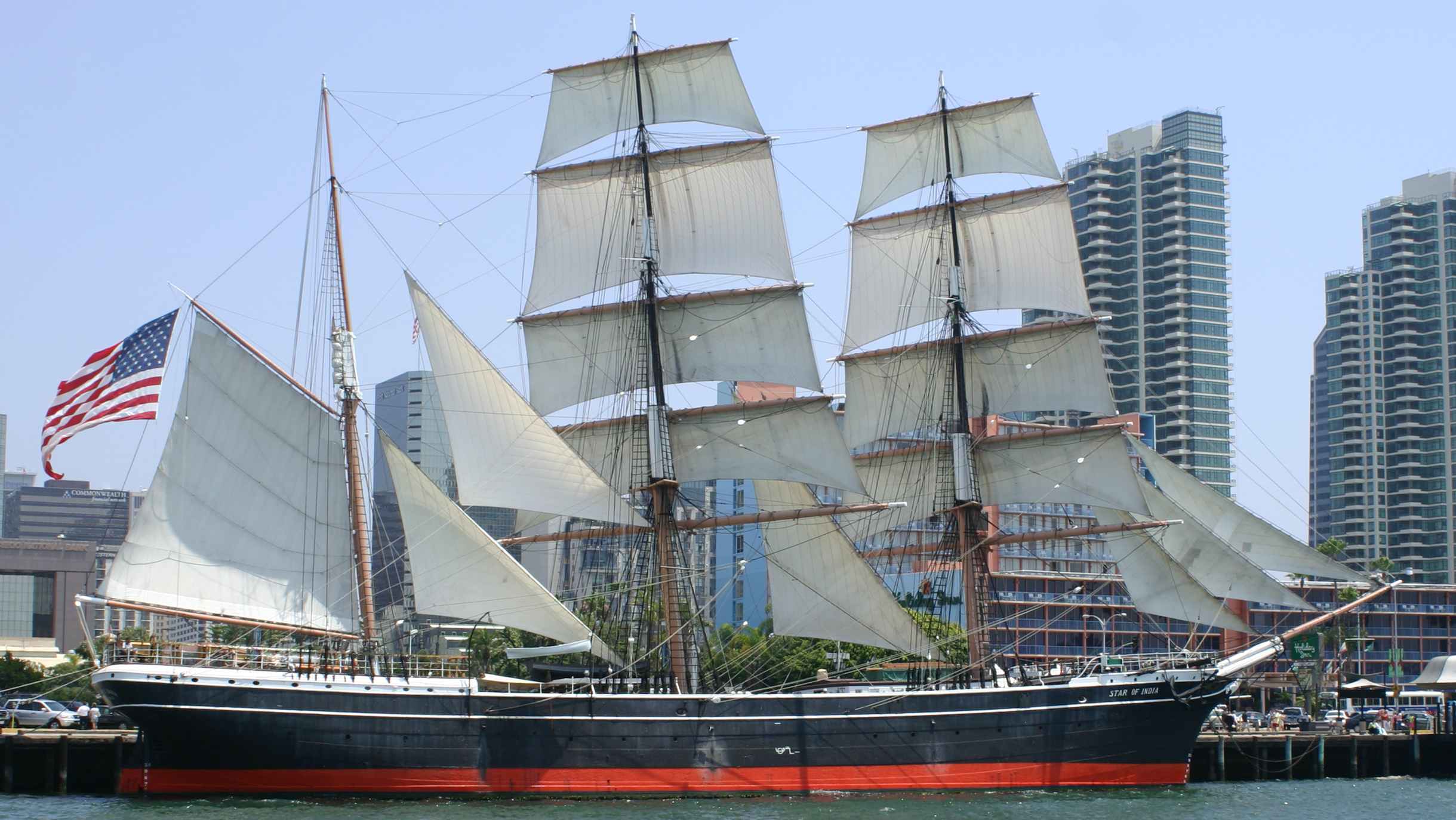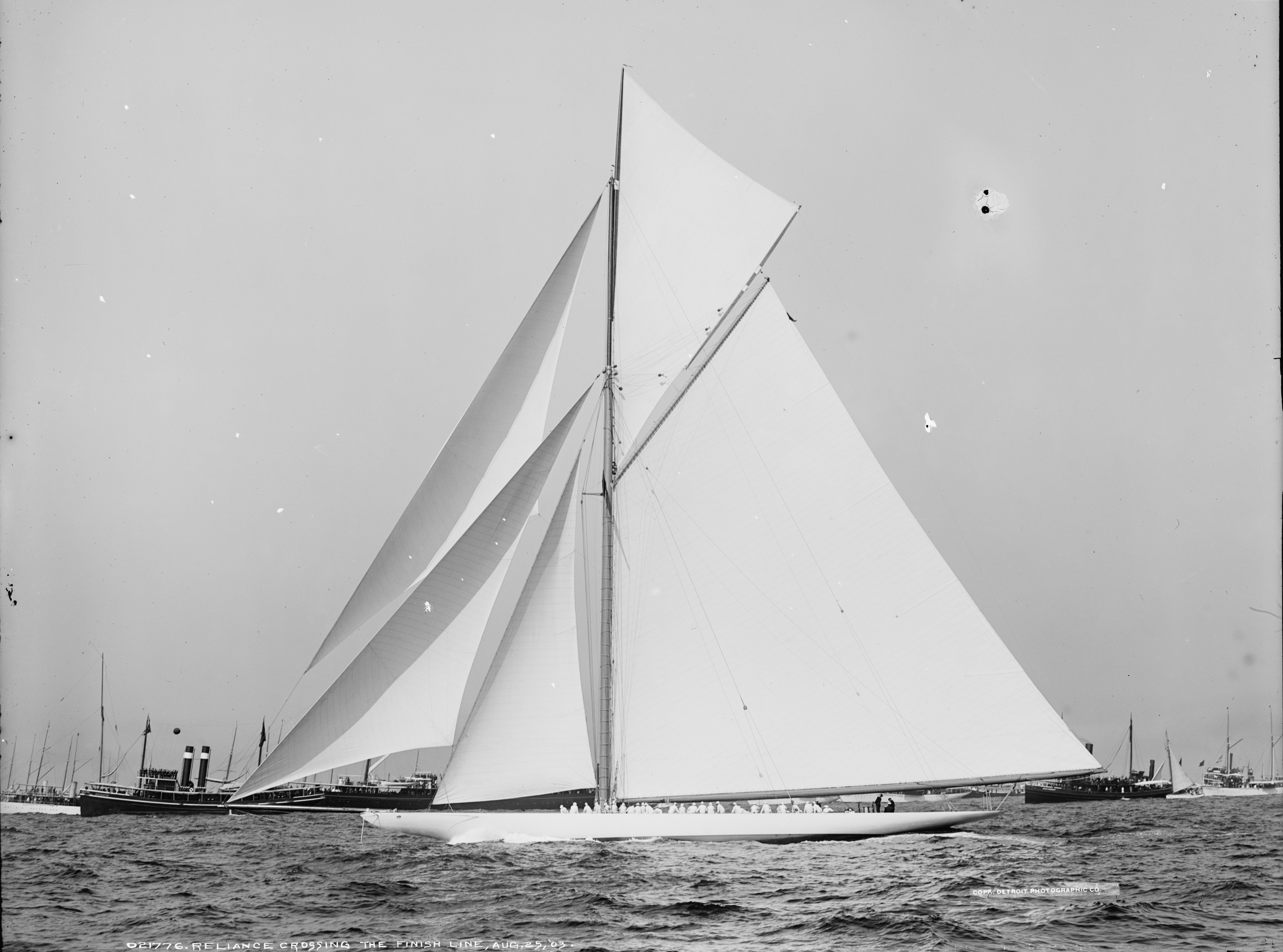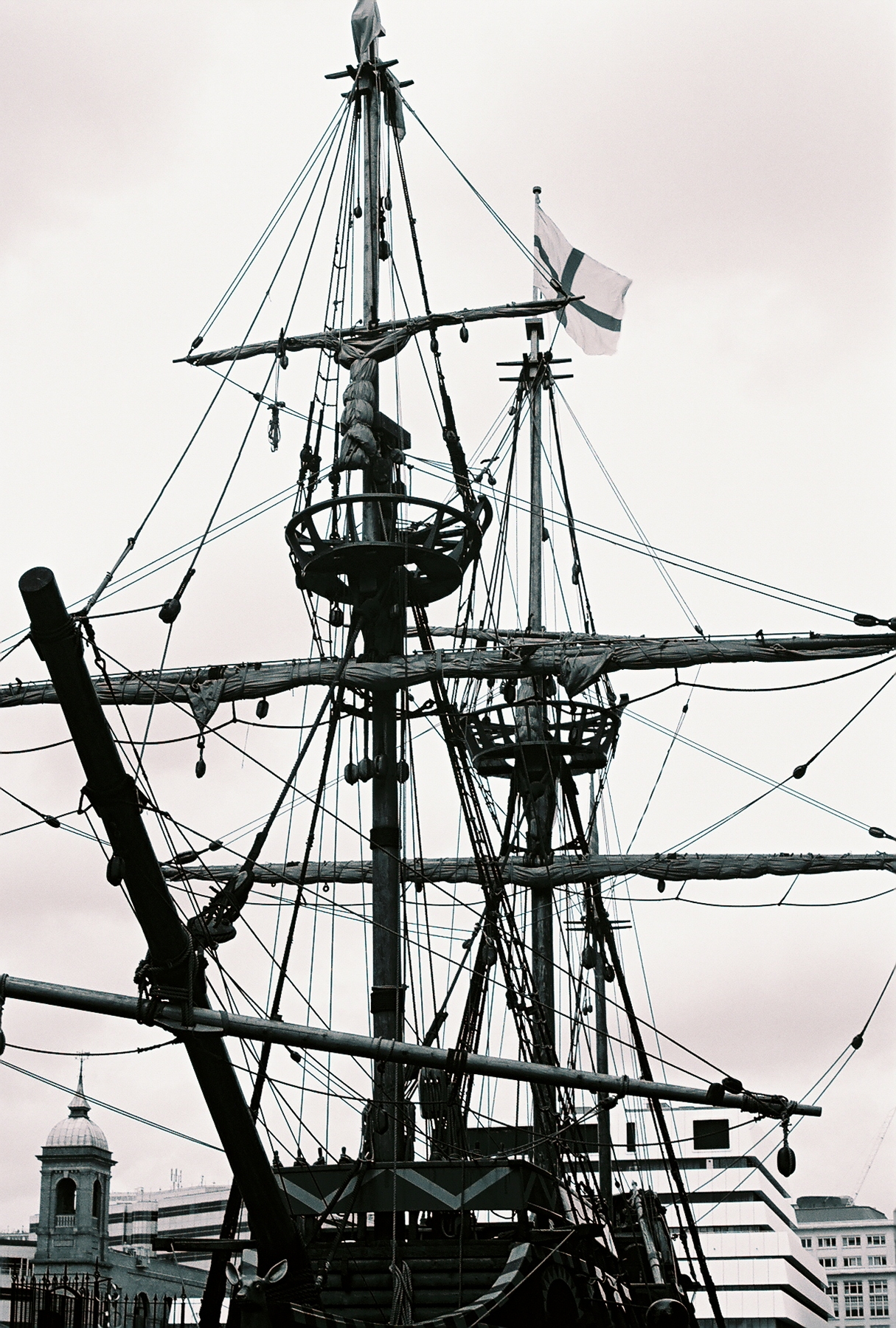|
Sailplan
A sail plan is a description of the specific ways that a sailing craft is rigged. Also, the term "sail plan" is a graphic depiction of the arrangement of the sails for a given sailing craft.> In the English language, ships were usually described, until the end of the eighteenth century, in terms of their type of hull design. Using the type of rig as the main type identifer for a vessel only became common in the nineteenth century. This is illustrated by the terminology for ships in the large fleet of colliers that traded to London from the coal ports of the Northeast of England (of which was a well-known example). Many of these full-rigged ships (square rigged on all of three masts) had the hull type "bark"another common classification was "cat". In the second half of the eighteenth century, the square sails on the mizzen were often eliminated. The resulting rig acquired the name of the hull type: initially as "bark" and soon as "barque". This explains the Royal Navy's descripti ... [...More Info...] [...Related Items...] OR: [Wikipedia] [Google] [Baidu] |
Gaff Rig
Gaff rig is a sailing rig (configuration of sails, mast and stays) in which the sail is four-cornered, fore-and-aft rigged, controlled at its peak and, usually, its entire head by a spar (pole) called the ''gaff''. Because of the size and shape of the sail, a gaff rig will have running backstays rather than permanent backstays. The gaff enables a fore and aft sail to be four sided, rather than triangular. A gaff rig typically carries 25 percent more sail than an equivalent Bermudian rig for a given hull design. A sail hoisted from a gaff is called a gaff-rigged (or, less commonly, gaff rigged or gaffrigged) sail. Description Gaff rig remains the most popular fore-aft rig for schooner and barquentine mainsails and other course sails, and spanker sails on a square rigged vessel are always gaff rigged. On other rigs, particularly the sloop, ketch and yawl, gaff rigged sails were once common but have now been largely replaced by the Bermuda rig sail, which, in addition to bei ... [...More Info...] [...Related Items...] OR: [Wikipedia] [Google] [Baidu] |
Spritsail
The spritsail is a four-sided, fore-and-aft sail that is supported at its highest points by the mast and a diagonally running spar known as the sprit. The foot of the sail can be stretched by a boom or held loose-footed just by its sheets. A spritsail has four corners: the throat, peak, clew, and tack. The Spritsail can also be used to describe a rig that uses a spritsail. Historically, spritsails were the first European fore-and-aft rigs, appearing in Greco-Roman navigation in the 2nd century BC. The rig The luff of the sail is bound to the mast, but unlike the gaff rig where the head is bound to a spar, this rig supports the leech of the sail by means of a diagonal spar or spars named a sprit ( ). The forward end of the sprit spar is attached to the mast, with the after end of the sprit spar attached to the peak. The sprit is steadied and controlled from the deck by a pair of wire vangs ( ) attached to the peak of the sail. It is said to be the ancestor of the common ga ... [...More Info...] [...Related Items...] OR: [Wikipedia] [Google] [Baidu] |
Trimaran
A trimaran (or double-outrigger) is a multihull boat that comprises a main hull and two smaller outrigger hulls (or "floats") which are attached to the main hull with lateral beams. Most modern trimarans are sailing yachts designed for recreation or racing; others are ferries or warships. They originated from the traditional double-outrigger hulls of the Austronesian cultures of Maritime Southeast Asia; particularly in the Philippines and Eastern Indonesia, where it remains the dominant hull design of traditional fishing boats. Double-outriggers are derived from the older catamaran and single-outrigger boat designs. Terminology The word "trimaran" is a portmanteau of "tri" and "(cata)maran", a term that is thought to have been coined by Victor Tchetchet, a pioneering, Ukrainian-born modern multihull designer. Trimarans consist of a main hull connected to outrigger floats on either side by a crossbeam, wing, or other form of superstructure—the traditional Polynesian terms f ... [...More Info...] [...Related Items...] OR: [Wikipedia] [Google] [Baidu] |
Centreboard
A centreboard or centerboard (US) is a retractable hull appendage which pivots out of a slot in the hull of a sailboat, known as a ''centreboard trunk'' (UK) or ''centerboard case'' (US). The retractability allows the centreboard to be raised to operate in shallow waters, to move the centre of lateral resistance (offsetting changes to the sailplan that move the centre of effort aft), to reduce drag when the full area of the centreboard is not needed, or when removing the boat from the water, as when trailering. A centreboard which consists of solely a pivoting metal plate is called a centerplate. A daggerboard is similar but slides vertically rather than pivoting. The analog in a scow is a bilgeboard: these are fitted in pairs and used one at a time. General History Lt. John Schank (c. 1740 – 6 February 1823) was an officer of the British Royal Navy and is credited with the invention of the centerboard. Schank, however, gave credit for the idea to British Brigadier General ... [...More Info...] [...Related Items...] OR: [Wikipedia] [Google] [Baidu] |
Fore And Aft Sails
A fore-and-aft rig is a sailing vessel rigged mainly with sails set along the line of the keel, rather than perpendicular to it as on a square rigged vessel. Description Fore-and-aft rigged sails include staysails, Bermuda rigged sails, gaff rigged sails, gaff sails, gunter rig, lateen sails, lug sails, tanja sails, the spanker sail on a square rig and crab claw sails. Fore-and-aft rigs include: * Rigs with one mast: the proa, the catboat, the sloop, the cutter * Rigs with two masts: the ketch, the yawl * Rigs with two or more masts: the schooner Barques and barquentines are partially square rigged and partially fore-and-aft rigged. A rig which combines both on a foremast is known as a hermaphroditic rig. History Austronesia The fore-and-aft rig is believed to have been first developed independently by the Austronesian peoples some time around 1500 BC with the invention of the crab claw sail. It is suggested that it evolved from a more primitive "V"-shaped "square" s ... [...More Info...] [...Related Items...] OR: [Wikipedia] [Google] [Baidu] |
Thames Barges-Canthusus
The River Thames ( ), known alternatively in parts as the River Isis, is a river that flows through southern England including London. At , it is the longest river entirely in England and the second-longest in the United Kingdom, after the River Severn. The river rises at Thames Head in Gloucestershire, and flows into the North Sea near Tilbury, Essex and Gravesend, Kent, via the Thames Estuary. From the west it flows through Oxford (where it is sometimes called the Isis), Reading, Henley-on-Thames and Windsor. The Thames also drains the whole of Greater London. In August 2022, the source of the river moved five miles to beyond Somerford Keynes due to the heatwave in July 2022. The lower reaches of the river are called the Tideway, derived from its long tidal reach up to Teddington Lock. Its tidal section includes most of its London stretch and has a rise and fall of . From Oxford to the Estuary the Thames drops by 55 metres. Running through some of the drier parts of mai ... [...More Info...] [...Related Items...] OR: [Wikipedia] [Google] [Baidu] |
DynaRig
The DynaRig is a conceptualization of a square-rigged form of rigging, designed in the 1960s by the German engineer Wilhelm Prölß. While having the appearance of the rigging of a 19th-century clipper ship, it was not actually implemented on a sailing vessel until several decades after its design because of a lack of adequate construction materials. It was fitted to one of the world's largest yachts, the '' Maltese Falcon''. When the original patent rights and residual technology were purchased from the German government by an American investor in 2001, it was renamed the Falcon rig. The DynaRig, along with the original, "DynaSchiff", is a trademarked name. The original concept by Prölß was for a combined rig and hull with extremely high efficiency of operation and the use of wind power to propel a large vessel across an open body of water. The modern controller for the entire ship's rig consists of a single panel operated by a single person. The masts are freestanding, the curv ... [...More Info...] [...Related Items...] OR: [Wikipedia] [Google] [Baidu] |
Footrope
Each yard on a square or gaff rigged sailing ship is equipped with a footrope for sailors to stand on while setting or stowing the sails. Formerly, the footrope was the rope sewn along the lower edge of a square sail, and the rope below the yards was called the horse or Flemish horse. These terms will be encountered when reading the classic 18th and 19th century sailing manuals, and may still be used today when referring to older ships. Although square sails are mostly worked from the deck, in order to be properly stowed (and released from this stowage) they must be folded by hand and tied to the yard with gaskets. This requires sailors to go aloft, during which time they stand on the footropes. The ropes are made of either fibre or wire, and are almost always protected from wear by being wormed, parcelled and served, so that the visible outer coating is of tarred thin line. They are attached to the yard via the jackstays or "handrails" to which the sails are also fastened, t ... [...More Info...] [...Related Items...] OR: [Wikipedia] [Google] [Baidu] |
Rigging
Rigging comprises the system of ropes, cables and chains, which support a sailing ship or sail boat's masts—''standing rigging'', including shrouds and stays—and which adjust the position of the vessel's sails and spars to which they are attached—the ''running rigging'', including halyards, braces, sheets and vangs. Etymology According to the Encyclopædia Britannica Eleventh Edition "rigging" derives from Anglo-Saxon ''wrigan'' or ''wringing'', "to clothe". The same source points out that "rigging" a sailing vessel refers to putting all the components in place to allow it to function, including the masts, spars, sails and the rigging. Types of rigging Rigging is divided into two classes, ''standing'', which supports the mast (and bowsprit), and ''running'', which controls the orientation of the sails and their degree of reefing. Configurations differ for each type of rigging, between ''fore-and-aft rigged'' vessels and ''square-rigged'' vessels. Standing Standin ... [...More Info...] [...Related Items...] OR: [Wikipedia] [Google] [Baidu] |
Yard (sailing)
A yard is a spar on a mast from which sails are set. It may be constructed of timber or steel or from more modern materials such as aluminium or carbon fibre. Although some types of fore and aft rigs have yards, the term is usually used to describe the horizontal spars used on square rigged sails. In addition, for some decades after square sails were generally dispensed with, some yards were retained for deploying wireless (radio) aerials and signal flags. Parts of the yard ; Bunt : The short section of the yard between the ''slings'' that attach it to the mast. ; Quarters : The port and starboard quarters form the bulk of the yard, extending from the slings to the fittings for the lifts and braces. ; Yardarms : The outermost tips of the yard: outboard from the attachments for the lifts. Note that these terms refer to stretches of the same spar, not to separate component parts. Controlling the yard The yard can rotate around the mast to allow the direction of the vess ... [...More Info...] [...Related Items...] OR: [Wikipedia] [Google] [Baidu] |
Square Rig
Square rig is a generic type of sail and rigging arrangement in which the primary driving sails are carried on horizontal spars which are perpendicular, or square, to the keel of the vessel and to the masts. These spars are called ''yards'' and their tips, outside the lifts, are called the ''yardarms.'' A ship mainly rigged so is called a square-rigger. The square rig is aerodynamically the most efficient running rig (i.e., sailing downwind), and stayed popular on ocean-going sailing ships until the end of the Age of Sail. The last commercial sailing ships, windjammers, were usually square-rigged four-masted barques. History The oldest archaeological evidence of use of a square-rig on a vessel is an image on a clay disk from Mesopotamia from 5000 BC. Single sail square rigs were used by the ancient Egyptians, the Phoenicians, the Greeks, the Romans, and the Celts. Later the Scandinavians, the Germanic peoples, and the Slavs adopted the single square-rigged sail, with it be ... [...More Info...] [...Related Items...] OR: [Wikipedia] [Google] [Baidu] |







